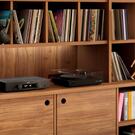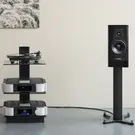The Axxess amplifier manufacturer, Audio Group Denmark, also makes Aavik amplifiers, Børresen speakers and Anzus cables. These are all well-established brands that stand entirely on their own two feet. Then there is the latest addition, the integrated Forté amplifiers in the Axxess series. There are three products in the series so far, but it’s hard to imagine that this new series of components won’t be expanded at a later date.
Well-equipped
Forté 3 consists of an amplifier, a headphone amplifier, a streamer and a DAC. The latter can also be connected to external digital sources and there are three digital inputs on the back. These are optical, BNC and USB B inputs. The maximum capacity is 2TB if you connect an external disk. There is also an analogue RCA input. The outputs are pre-out, a 6.25 mm headphone outlet and, of course, a solid speaker output.
Like the Aavik amplifiers, Fortè has been designed with larger chassis elements made from composite materials and it looks decidedly different to most other amplifiers available today. The large and very easy to read display, the sophisticated volume control dial and the profiling around the chassis give the amplifier a new and exciting, perhaps even slightly futuristic, look. I think it looks stylish, but I can understand that it might divide the audience.
The fairly flat but surprisingly lightweight chassis provides high levels of resonance dampening due to the extensive use of composite materials. Forté 3 is the only product in the series to be equipped with a solid copper plate at the bottom. There are sturdy feet on the underside, which has been milled to make space for Darkz feet, but there is also space for feet on the top panel if you need to stack your Axxess products.
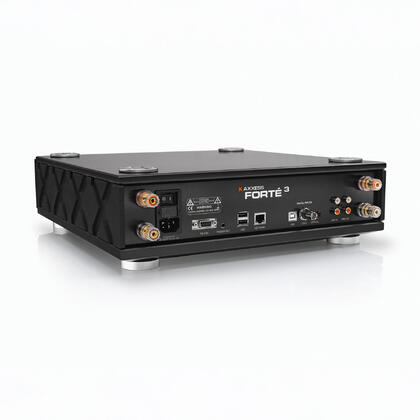
UMAC amplifier
The UMAC amplifier technology comes from Pascal and is class D, outputting 2 x 100 watts in this case. UMAC is the same technology that is used in Aavik’s amplifiers, but it is also used in a couple of other products we have recently listened to: the active Fokus 50 and Fokus 30 speakers from Dynaudio.
One of the specialities of the Aavik amplifiers is the extensive use of Tesla coils. This means that there are 108 Tesla coils, 216 square Tesla coils and 4 zirconium Tesla coils on the inside. In Forte, nine Dither circuits are also used. Dither is a technique that is used to reduce or minimise unwanted noise that may occur when digital signals are converted from a higher to lower resolution. Dither helps to retain the necessary detailed information and to maintain a smoother transition between signal levels.
1-bit DAC
According to the designer, the challenge of a traditional multi-bit circuit in a DAC section relates to managing increased noise pollution and signal delays, which distort the music with an unwanted “digital signature”. Axxess Forté has a 1-bit circuit, which was developed in-house and ensures an analogue sound signature. With fast data processing and high resistance against noise, the Axxess Forté DAC ensures better clarity and precision, which in turn leads to calm and relaxing music.
App control
Axxess uses a variant of mConnect as its control app. It works well and is clear and sufficiently user-friendly. It can be used to control the volume, but this can be somewhat challenging, as it is easy to move the slider too far towards the right of the app. It does not increase the volume while it is being moved, only after it has been released. And there was at least one occasion when this resulted in the volume being too loud. Fortunately, the well-built remote functions flawlessly.
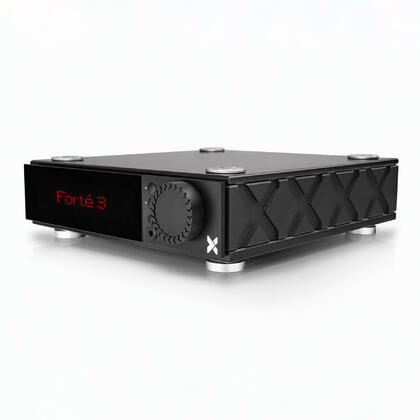
Quiet and relaxed
It wasn’t all that long ago that class D amplifiers were generally considered to be choppy and jumpy and it could even be argued that they lacked one key factor for sound reproduction - musicality. This is no longer a credible objection for this class, although it is still said when discussing audio quality.
With this product, this is not noticeable at all from the deepest of bass sounds until the ear no longer manages to keep up and the experience is just as smooth as what we have experienced with any other amplifier technology. What’s more, class D amplifiers generally also maintain excellent control of the bass and that is also the case when it comes to Forté 3.
This is why we divide amplifiers into good, not quite as good and unsatisfactory, although it is becoming increasingly difficult to find equipment that belongs to the latter category. We cannot use the amplifier class or design principle when selecting test products or to establish any expectation of audio quality.
In testing, we connected the Forté to a couple of Børresen X3 and Focal Kanta 3 speakers. These are two very different speakers with very different characteristics and different sets of challenges for the amplifier to solve.
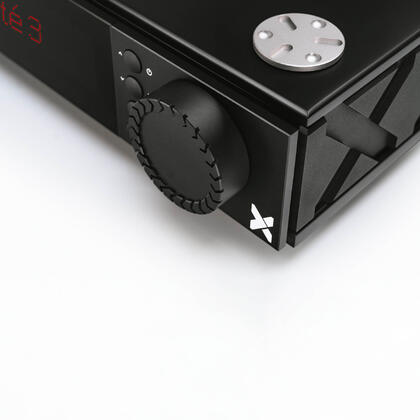
Great sound quality
I used the built-in streamer in Forté 3 as the audio source during testing, playing music from Tidal and Qobuz, which are now more or less overused as our playlists, and I made sure I was comfortable and perfectly positioned for the sweet spot of the soundscape. Not the worst office situation to be in!
Regardless of genre and format, it is easy to recognise that the sound quality is excellent. Additionally, the sound is both comfortable and relaxing - much like the Aavik amplifiers from the same manufacturer. There is a clear common theme in their approach to music reproduction and what it delivers is actually very likable. It is not entirely surprising but it is still nice to have it confirmed.

It is a bit strange to listen to an amplifier with such control of the bass, while also being light-footed, open and relaxed in the midrange and treble. So much so, that I experienced some quite extensive spells of goosebumps. For some reason, this happens relatively frequently and always when listening to great female voices, but even the opening to Saint-Saëns’ Violin Concerto no. 1 in A major struck me in a way that led to an extensive bout. It’s lovely when this happens and proves that we shouldn’t mess with the subconscious. It is completely honest and sends clear and wild signals to the body that there is something special going on. It’s not always easy to know what that something “special” is, but it is still a clear and affirmative sign of a positive audio experience. It doesn’t always happen, even if you are ever so positively inclined towards the product and you play music that, when everything is at its very best, causes the nervous system to trigger a completely uncontrollable response.
The direction the sound travels from the speakers is irrelevant when it does happen. Focal Kanta 3 and Børresen X3 have very different approaches to music. Kanta 3 has a very detailed, precise treble and midrange and a beautiful, deep bass, while the X3 focuses less on the details and has a large, fairly relaxed soundscape and a nice bass, without going as far down into the basement as Kanta 3.
Of course, another key factor is the intimacy of the music when penning a final conclusion and the experience you get from the electronics and speakers can sometimes inspire you to listen to even more music and deep-dive into recordings from your favourite artists. These are qualities that are quite evident in Forté 3 and quickly become apparent when I start playing music. So I decide to play Anette Askvik and her Liberty, in which Petter Wettre is very much at the front of the soundscape with his tenor saxophone. In addition to Askvik’s beautiful voice, the recording also includes a great deal of hi-fi extras that generate excitement, spatiality and occasional interesting variations in the soundscape. The space is huge and impressive, while the position and focus on instruments are also very good. But it’s when Wettre comes in on his saxophone that it takes off completely. The tone is natural, warm and inviting and extremely natural and relaxed. The sound of the instruments is rich and provides a very enjoyable brass experience.
How about music with slightly harder edges and heavy guitars? I decided to play Invincible by Tool and it plays really well, the guitars have strength, a solid base and just the right string thickness. It is dynamic, pushy and heavy when it should be but the sound never gets tiresome or too sharp for the ears. Tool’s precise and well-produced progressive metal is surprisingly difficult to reproduce, but there was definitely a party on the sofa. The distance between the instruments is good and the vocals are centred and suitably prominent in the soundscape.
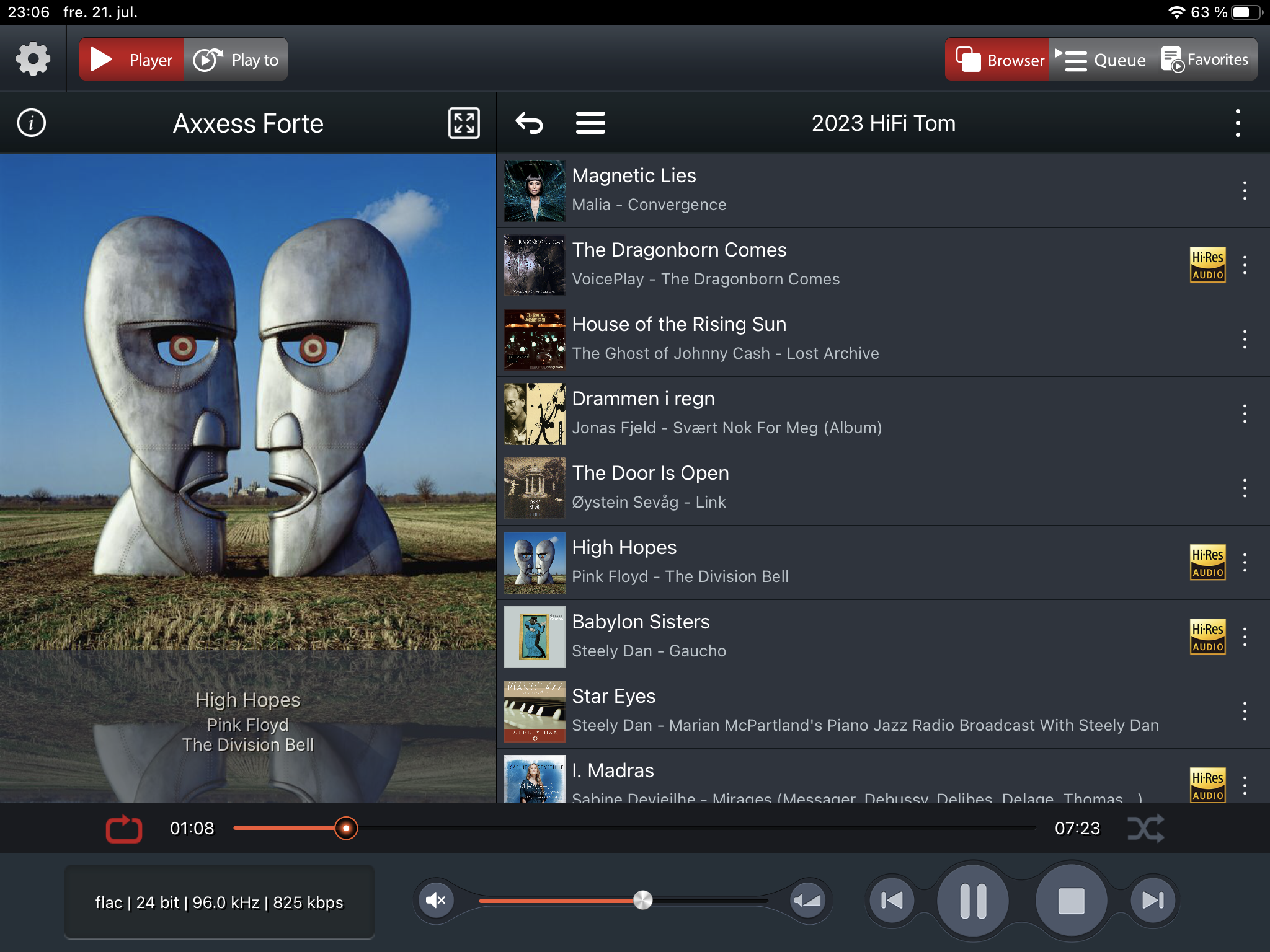
Comfortably Numb is available in a plethora of versions, but has David Gilmour ever performed a better guitar solo than he did on Live in Gdansk? He comes across as inspired and playful and the live recording sounds excellent. The sound is impressive, the band is suitably heavy and the amplifier brings out the signature tone of Gilmour’s Fender Stratocaster beautifully. I brush the dust off my air guitar, throw my head back and play along as best I can.
I want to listen to something more soaring and put on Sigur Rós and the song Bló∂berg. It’s easy to notice the effects layers and the tones that have been added to the strings and I almost jump when the vocals start. It sounds frighteningly close and raw and is beautifully focused and reproduced. Both the width and the depth of the space is substantial and there is plenty of room for both string instruments and synthetic tones to frolic.
The amplifier is neutral and well-balanced and not too pushy or light, but it is also honest enough to not hold anything back when the recording gives a little extra in the top part of the frequency range. This can make the sound somewhat demanding when used with certain speakers and Focal Kanta 3 might represent a sort of limit for how active and energetic your speakers should be when combined with Axxess Forte 3. However, the amplifier is so tight and controlled that it could easily be exactly what you need for a couple of lazy and boring speakers.
Conclusion
The scepticism surrounding class D amplifiers may have been understandable at one point in time, but it is now time to move on. There has been a serious boost to the technology in the last 4-5 years and when the technology is properly implemented, as is the case here, the class D technology provides excellent control and high precision in reproduction, as well as rhythmic propulsion and dynamics that lead to a vibrant sound and immersive listening experience.
Denmark Audio Group has done an excellent job with Axxess and has developed an amplifier that seems to be very well balanced with a great DAC and well-matched streamer. This makes it a solid hub for digital hi-fi systems and well worth taking home for a trial run.

 Vipps oss en gave: 129702
Vipps oss en gave: 129702
